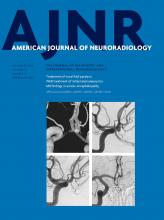We would like to thank Dr Bhatia and colleagues for their interest in our article and their comments. Indeed, we did not separately analyze the pediatric population in our cohort, and we acknowledge it would be interesting to further evaluate this group and compare our findings with theirs.
Therefore, we further investigated our subpopulation of posterior reversible encephalopathy syndrome cases and updated our data base to include additional pediatric patients to evaluate the importance of contrast enhancement. In total, we identified 30 contrast-enhanced MR imaging cases of pediatric patients with posterior reversible encephalopathy syndrome. Of these, 26 (87%) patients were immunosuppressed. Our cohort's characteristics substantially differ from the authors' own cohort (62.5% with renal disease); hence, there is a limitation in comparing findings between both studies.1
Within this group, 60% (n = 18) of patients demonstrated evidence of contrast enhancement, a rate higher than our earlier findings of 43.7% in the general population.2 Similarly, we found no correlation between presence/pattern of contrast enhancement and any of the outcome scores of tested variables. However, and interestingly, we no longer found an association between MR imaging severity and outcome scores in the new pediatric cohort (P < .05). This contrasts with our earlier findings in the general population, but this new cohort suffers considerably from its much smaller size and diminished statistical power.
We find the authors' observations regarding the frequency of atypical MR imaging features and how that could limit our proposed MR severity index scale interesting. However, we believe that in both our current study and a previous study from 1 of the authors (A.M.M), these atypical findings would be appropriately covered in this scale.3 In particular, Casey et al4 and Covarrubias et al5 previously suggested high severity in posterior reversible encephalopathy syndrome when basal ganglia or brain stem involvement was found, which was taken into account when grading MR imaging severity. Atypical features in posterior reversible encephalopathy syndrome previously were shown to be relatively frequent, with frontal involvement seen in up to 78.9% of patients, thalamic involvement in up to 30.3%, and cerebellar involvement in up to 34.2%.3
References
- © 2016 by American Journal of Neuroradiology







